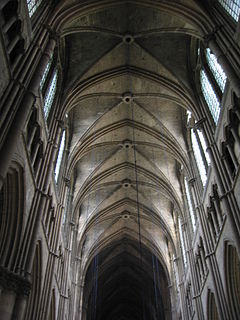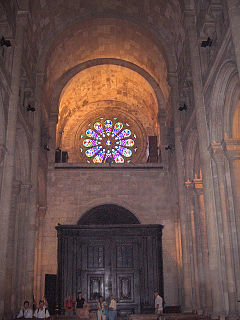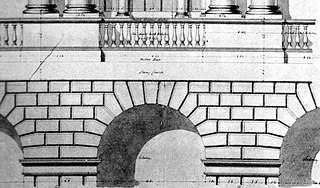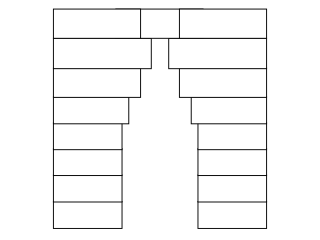
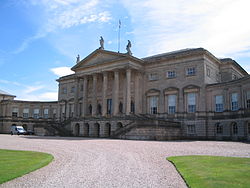
Quadrant in architecture refers to a curve in a wall or a vaulted ceiling. Generally considered to be an arc of 90 degrees - one quarter of a circle, or a half of the more commonly seen architectural feature - a crescent.
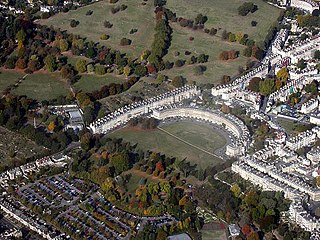
A crescent is an architectural structure where a number of houses, normally terraced houses, are laid out in an arc to form a crescent shape. A famous historic crescent is the Royal Crescent in Bath, England.
The quadrant curve in architecture was a feature popularised by Palladio who used it often for the wings and colonnades which linked his classical style villas to their service wings and out-buildings. However, curved quadrant buildings should not be confused with the canted facades of Baroque architecture or the slightly curved buildings of the era such as the Quattro Canti in Palermo.

Servants' quarters are those parts of a building, traditionally in a private house, which contain the domestic offices and staff accommodation. From the late 17th century until the early 20th century, they were a common feature in many large houses. Sometimes they are an integral part of a smaller house—in the basements and attics, especially in a town house, while in larger houses they are often a purpose-built adjacent wing or block. In architectural descriptions and guidebooks of stately homes, the servants' quarters are frequently overlooked, yet they form an important piece of social history, often as interesting as the principal part of the house itself.
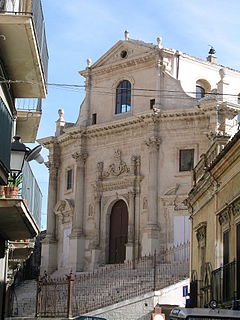
Cant or canted in architecture is an angled (oblique) line or surface particularly which cuts off a corner.

The Baroque is a highly ornate and often extravagant style of architecture, music, dance, painting, sculpture and other arts that flourished in Europe from the early 17th until the mid-18th century. It followed the Renaissance style and preceded the Rococo and Neoclassical styles. It was encouraged by the Catholic Church as a means to counter the simplicity and austerity of Protestant architecture, art and music, though Lutheran Baroque art developed in parts of Europe as well. The Baroque style used contrast, movement, exuberant detail, deep colour, grandeur and surprise to achieve a sense of awe. The style began at the start of the 17th century in Rome, then spread rapidly to France, northern Italy, Spain and Portugal, then to Austria and southern Germany. By the 1730s, it had evolved into an even more flamboyant style, called rocaille or Rococo, which appeared in France and central Europe until the mid to late 18th century.
The quadrant vault, a feature of Tudor architecture, is a curving interior - a continuous arc usually of brick, as seen in a tunnel - as opposed to a ribbed vault where a framework of ribs or arches supports the curves of the vault. A quadrant arch was often employed in Romanesque architecture to provide decorative support, as seen in the flying buttresses of Notre-Dame de Chartres built in the second half of the 12th century.

A tunnel is an underground passageway, dug through the surrounding soil/earth/rock and enclosed except for entrance and exit, commonly at each end. A pipeline is not a tunnel, though some recent tunnels have used immersed tube construction techniques rather than traditional tunnel boring methods.

Romanesque architecture is an architectural style of medieval Europe characterized by semi-circular arches. There is no consensus for the beginning date of the Romanesque style, with proposals ranging from the 6th to the 11th century, this later date being the most commonly held. In the 12th century it developed into the Gothic style, marked by pointed arches. Examples of Romanesque architecture can be found across the continent, making it the first pan-European architectural style since Imperial Roman architecture. The Romanesque style in England is traditionally referred to as Norman architecture.

The flying buttress is a specific form of buttress composed of an arch that extends from the upper portion of a wall to a pier of great mass, in order to convey to the ground the lateral forces that push a wall outwards, which are forces that arise from vaulted ceilings of stone and from wind-loading on roofs.
During the 18th century, the quadrant once again became a popular design shape for the terraces of smart houses in fashionable spa towns such as Buxton. Henry Currey's "Quadrant", built to rival the architecture of Bath, is considered one of Buxton's finest buildings.
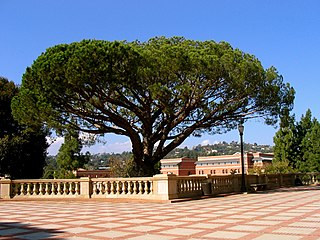
A terrace is an external, raised, open, flat area in either a landscape near a building, or as a roof terrace on a flat roof.

A spa town is a resort town based on a mineral spa. Patrons visit spas to "take the waters" for their purported health benefits. The word spa is derived from the name of Spa, a town in Belgium.

Buxton is a spa town in Derbyshire, in the East Midlands region of England. It has the highest elevation – about 1,000 feet (300 m) above sea level – of any market town in England. Close to the county boundary with Cheshire to the west and Staffordshire to the south, Buxton is described as "the gateway to the Peak District National Park". A municipal borough until 1974, Buxton was then merged with other localities lying primarily to the north, including Glossop, to form the local government district and borough of High Peak within the county of Derbyshire. Despite being in the East Midlands, economically Buxton is within the sphere of influence of Greater Manchester. The population of the town was 22,115 at the 2011 Census.





